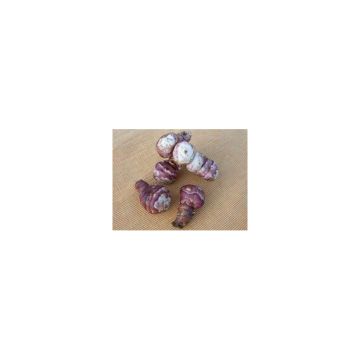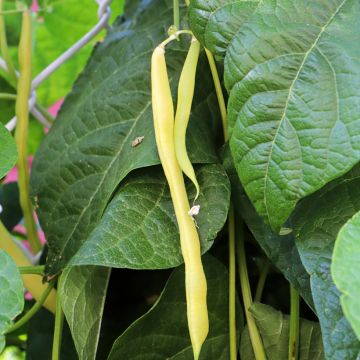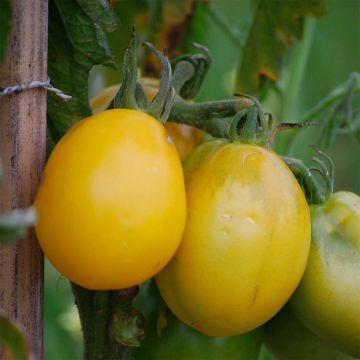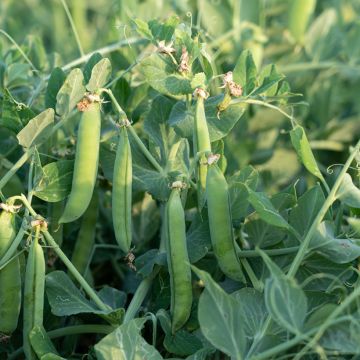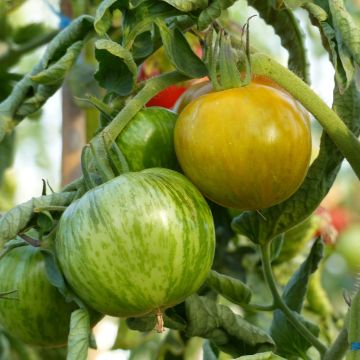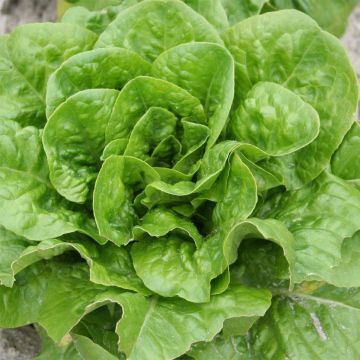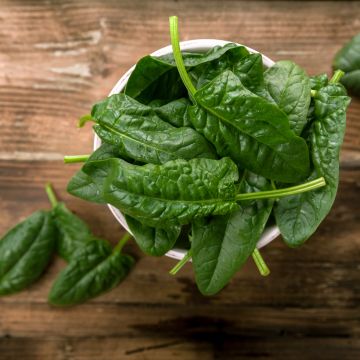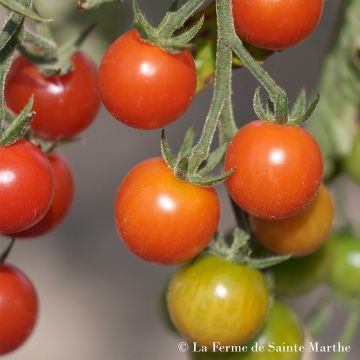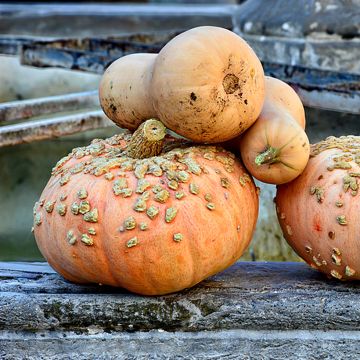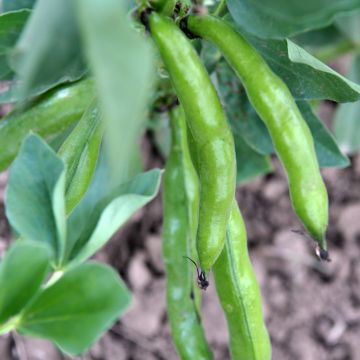

Jerusalem Artichokes - Helianthus tuberosus
Helianthus tuberosus Fuseau Culinaire
Jerusalem artichoke, sunroot, sunchoke, earth apple
This plant carries a 6 months recovery warranty
More information
We guarantee the quality of our plants for a full growing cycle, and will replace at our expense any plant that fails to recover under normal climatic and planting conditions.
From €5.90 for pickup delivery and €6.90 for home delivery
Express home delivery from €8.90.
From €5.90 for pickup delivery and €6.90 for home delivery
Express home delivery from €8.90.
Delivery to Corse prohibited: UE law prohibits the import of this plant from mainland France to Corse as part of the fight against Xylella fastidiosa. Please accept our sincere apologies.
More information
Description
The Fuseau Culinaire Jerusalem Artichoke is a variety that produces elongated tubers, with a light beige skin and slightly sweet white flesh. This root vegetable has a flavour reminiscent of artichoke. Its flowers, resembling those of a sunflower, are highly decorative. Plant the tubers in March-April for a harvest throughout the winter, from November to March.
The Jerusalem artichoke is grown for its elongated tubers, which have a delicate flavour reminiscent of artichoke. Like the sunflower, it belongs to the same species. At the end of summer, small sun-shaped flowers will appear. With stems reaching 2m (7ft) in height, the Jerusalem artichoke is interesting to grow as a border in the vegetable garden or as a summer hedge to provide some shade. Choose carefully where you want to plant it. Indeed, this perennial and hardy plant spreads very quickly from the remaining tubers left after harvest. Therefore, precisely delimit the area where you want to cultivate it and remove any regrowth the following spring if necessary.
Cooked and peeled, Jerusalem artichokes can be used in gratins, stir-fries, or mashed. Consume them in small quantities as they can sometimes be difficult to digest. However, you can enjoy them throughout the winter as they are one of the last vegetables harvested from the vegetable garden.
Harvesting: Dig up the tubers with a garden fork after the first frosts, when the foliage has turned black. Very hardy, Jerusalem artichokes can withstand frost and can be harvested from November to March, as needed.
Storage: The tubers should be consumed quickly after harvest, within 2 to 3 days.
Gardener's tip: We recommend mulching the soil with thin successive layers of grass clippings, if possible mixed with dead leaves. This protection, which keeps the soil moist, also reduces weed growth. Additionally, a thick mulch will make harvesting easier during the winter period.
Report an error about the product description
Jerusalem Artichokes - Helianthus tuberosus in pictures
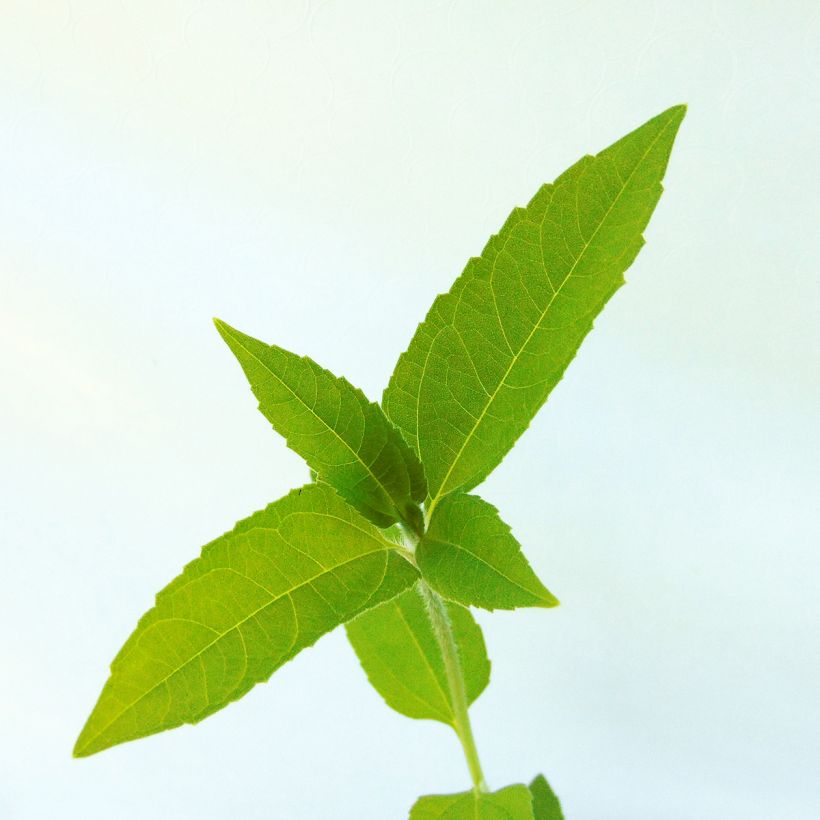

Harvest
Plant habit
Foliage
Other Jerusalem Artichokes
Planting and care
Planting is done using tubers. The Jerusalem artichoke thrives in most types of soil, with a preference for loose, fairly rich, and well-drained soil. It enjoys sunny exposures and sheltered locations.
The previous autumn, enrich the soil with well-rotted compost by raking it in to a depth of 5cm (2in) after loosening the soil.
Plant the tubers in March-April, at a depth of 10cm (4in). Space them 70cm (28in) apart in all directions.
Weed, especially at the beginning of cultivation. Mound up when the stem is developed and reaches 20cm (8in).
Watering is not necessary, except in case of drought.
You can install supports to prop up the stems.
Cultivation
Care
Intended location
-
, onOrder confirmed
Reply from on Promesse de fleurs
Old and forgotten vegetables
Haven't found what you were looking for?
Hardiness is the lowest winter temperature a plant can endure without suffering serious damage or even dying. However, hardiness is affected by location (a sheltered area, such as a patio), protection (winter cover) and soil type (hardiness is improved by well-drained soil).

Photo Sharing Terms & Conditions
In order to encourage gardeners to interact and share their experiences, Promesse de fleurs offers various media enabling content to be uploaded onto its Site - in particular via the ‘Photo sharing’ module.
The User agrees to refrain from:
- Posting any content that is illegal, prejudicial, insulting, racist, inciteful to hatred, revisionist, contrary to public decency, that infringes on privacy or on the privacy rights of third parties, in particular the publicity rights of persons and goods, intellectual property rights, or the right to privacy.
- Submitting content on behalf of a third party;
- Impersonate the identity of a third party and/or publish any personal information about a third party;
In general, the User undertakes to refrain from any unethical behaviour.
All Content (in particular text, comments, files, images, photos, videos, creative works, etc.), which may be subject to property or intellectual property rights, image or other private rights, shall remain the property of the User, subject to the limited rights granted by the terms of the licence granted by Promesse de fleurs as stated below. Users are at liberty to publish or not to publish such Content on the Site, notably via the ‘Photo Sharing’ facility, and accept that this Content shall be made public and freely accessible, notably on the Internet.
Users further acknowledge, undertake to have ,and guarantee that they hold all necessary rights and permissions to publish such material on the Site, in particular with regard to the legislation in force pertaining to any privacy, property, intellectual property, image, or contractual rights, or rights of any other nature. By publishing such Content on the Site, Users acknowledge accepting full liability as publishers of the Content within the meaning of the law, and grant Promesse de fleurs, free of charge, an inclusive, worldwide licence for the said Content for the entire duration of its publication, including all reproduction, representation, up/downloading, displaying, performing, transmission, and storage rights.
Users also grant permission for their name to be linked to the Content and accept that this link may not always be made available.
By engaging in posting material, Users consent to their Content becoming automatically accessible on the Internet, in particular on other sites and/or blogs and/or web pages of the Promesse de fleurs site, including in particular social pages and the Promesse de fleurs catalogue.
Users may secure the removal of entrusted content free of charge by issuing a simple request via our contact form.
The flowering period indicated on our website applies to countries and regions located in USDA zone 8 (France, the United Kingdom, Ireland, the Netherlands, etc.)
It will vary according to where you live:
- In zones 9 to 10 (Italy, Spain, Greece, etc.), flowering will occur about 2 to 4 weeks earlier.
- In zones 6 to 7 (Germany, Poland, Slovenia, and lower mountainous regions), flowering will be delayed by 2 to 3 weeks.
- In zone 5 (Central Europe, Scandinavia), blooming will be delayed by 3 to 5 weeks.
In temperate climates, pruning of spring-flowering shrubs (forsythia, spireas, etc.) should be done just after flowering.
Pruning of summer-flowering shrubs (Indian Lilac, Perovskia, etc.) can be done in winter or spring.
In cold regions as well as with frost-sensitive plants, avoid pruning too early when severe frosts may still occur.
The planting period indicated on our website applies to countries and regions located in USDA zone 8 (France, United Kingdom, Ireland, Netherlands).
It will vary according to where you live:
- In Mediterranean zones (Marseille, Madrid, Milan, etc.), autumn and winter are the best planting periods.
- In continental zones (Strasbourg, Munich, Vienna, etc.), delay planting by 2 to 3 weeks in spring and bring it forward by 2 to 4 weeks in autumn.
- In mountainous regions (the Alps, Pyrenees, Carpathians, etc.), it is best to plant in late spring (May-June) or late summer (August-September).
The harvesting period indicated on our website applies to countries and regions in USDA zone 8 (France, England, Ireland, the Netherlands).
In colder areas (Scandinavia, Poland, Austria...) fruit and vegetable harvests are likely to be delayed by 3-4 weeks.
In warmer areas (Italy, Spain, Greece, etc.), harvesting will probably take place earlier, depending on weather conditions.
The sowing periods indicated on our website apply to countries and regions within USDA Zone 8 (France, UK, Ireland, Netherlands).
In colder areas (Scandinavia, Poland, Austria...), delay any outdoor sowing by 3-4 weeks, or sow under glass.
In warmer climes (Italy, Spain, Greece, etc.), bring outdoor sowing forward by a few weeks.

































